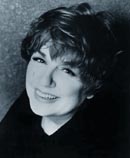
|
|
|
|
|
|
Photo Credit: Eric Stephen Jacobs |
Carol Sloane
For this program Dr. Taylor takes his show to the Roosevelt Theater in Altoona, PA. His guest is Carol Sloane, a talented singer who had her first professional gig at age 14. Inspired by Carmen McRae and others, Sloane developed a style of unmistakable elegance and warmth. Sloane, who has performed with such luminaries as Ella Fitzgerald, Jon Hendricks and Tommy Flanagan, can scat a swing favorite or whisper a bittersweet ballad. Apart from her talents as a singer, she is also a jazz disc jockey in her native New England. Sloane broadcasts her love of the music with an upbeat rendition of "You Make Me Feel So Young" to start the broadcast. When Sloane was a young girl in Providence, RI, she was surrounded by singers. She tells Dr. Taylor that her uncle was a professional musician and that he helped her get her first job. Offstage, Sloane learned about jazz from the owner of the local record store, who introduced her to records by giants like Ben Webster and Art Tatum. Her informal musical education forced Sloane to rely on her ears, and she never learned how to read music. That didn't keep her from filling in with Dave Lambert and Jon Hendricks when Annie Ross was unavailable for an early 1960s gig in Philadelphia. The first tune called that night was Duke Ellington's "Cottontail." Sloane reprises that performance as she blazes through Jon Hendricks' frenetic, tongue-twisting lyric with Dr. Taylor's trio hot on her trail. Not long after her fill-in gig Sloane moved to New York, where she had the opportunity to perform with many great pianists including Tommy Flanagan and Kenny Barron. She also met one of her idols: Carmen McRae. Sloane especially admired how McRae would sing a ballad by herself at the piano. "She carried her luggage with her around the stage," Sloane tells Dr. Taylor. "When she had a broken heart we knew it. She allowed us to her have her soul and her feelings." The singer at first gave Sloane a cool reception but eventually befriended her and proved to be a supportive mentor. After performing the light bossa "I'll Buy You a Star," Sloane discusses her radio show on WICN in Worcester, MA. Though the studios are an hour from her home, Sloane commutes five days a week for her four-hour show and sees her mission as an educational one. She also has taught at the New England Conservatory of Music in Boston, where her students learned the right way to kick off a melody. "The most important notes you're gonna ever sing is the first note of the song," Sloane explains. "If you hit that one sideways, then you're already in the drink." She demonstrates the art by jumping into "I'm Gonna Lock My Heart and Throw Away the Key." A question from the audience prompts Sloane and Dr. Taylor to reflect on the glory days of jazz radio. In the 1940s, Dr. Taylor explains, there were more opportunities to hear the music on the air. "Symphony Sid" Torrin, for example, had his show from New York's Birdland that aired nationally on ABC radio. Sloane remembers those broadcasts fondly: "The music, the clinking of the glasses, the little laugh that says there's something going on there-I longed to go to Birdland when I was fourteen." Rather than sing the paean "Lullaby of Birdland," Sloane and Dr. Taylor choose the Rodgers and Hart classic, "My Romance."
No jazz singer can talk about the craft without mentioning Ella Fitzgerald. Sloane knew the great singer from touring with her many years ago. Fitzgerald told Sloane that her favorite song was Billy Strayhorn's "Something to Live For," a tune about the emptiness of success without love. Fitzgerald's humility amazed Sloane, and she recounts how, commenting on her fame, Fitzgerald once said: "I don't think I've got such a special voice. I think it must be the songs I sang." Sloane says that no voice has come near the mastery and beauty of Fitzgerald's. Dr. Taylor heartily agrees. Yet, Fitzgerald's spirit is almost certainly present when Sloane and the trio close the show with the mischievous "Bad Influence" and Duke Ellington's swinging "Love You Madly."
|
|
| |
